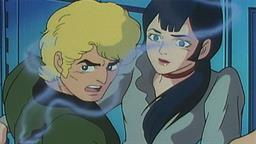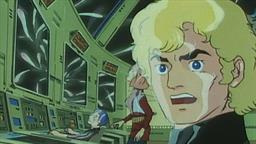

Featuring robots being worshipped as gods and much of the literal universe being destroyed, this robot anime was directly cited by Hideaki Anno as an influence on Neon Genesis Evangelion. This time, Tomino leaned even heavier into esoteric elements than he did in Gundam, which, despite being a realistic portrayal of war, also featured psychics who were a ‘new type of human’. With a design by ‘Submarine’, Ideon the robot always forgoes super-robot aesthetics completely and helped to usher in a visual style we’d see in Macross and the like. By the time Ideon started, Tomino may well have been on thin ice at Sunrise but that didn’t stop him from exerting his always grand version.
#Space runaway ideon stream series
Ideon premiered just months after Gundam, and at the time that series had yet to become a hit, with its original episode vastly cut.

The romantically titled Space Runaway Ideon Here we might have Yoshiyuki Tomino’s second most influential creation if we conveniently ignore literally every single Mobile Suit Gundam sequel he’d go on to create. We say early, but he’d already been a veteran, (15 years since starting at Tezuka’s Mushi Pro) and it was these two anime, not Gundam, that earned him his nearly half-century-old ‘Kill Em All Tomino’ moniker. While they’re still spiritually within the realm of the ‘Super Robot’ paradigm (more superheroic and less PTSD-sustained-from-war in to oversimplify it) you can see early traces of Tomino trying to do his thing here.

Produced in 19 respectively at Sunrise (then called Nippon Sunrise), these two shows were direct ancestors to Mobile Suit Gundam. Invincible Super Man Zambot 3 along with Invincible Steel Man Daitarn 3 (and before you ask no neither had a ‘1’ or ‘2’) were Yoshiyuki Tomino’s first real foray into the flourishing mech anime sub-genre popularized in the mid-70s by works like Tetsujin 28 and Mazinger Z. They don’t make robots like Zambot 3 anymore, an early design by the aforementioned Kunio Okawara who’d go on to put the Gundam design to paper. He might not have drawn the original Gundam RX 78-2’s line-art, but it’s first and foremost his baby Really, all mecha anime 1979 and onwards are.įirst comes first though we need to look at the early years. But even the work of famed mech designers like Kunio Okawara, with whom Tomino worked with closely for years, wouldn’t have been the same without the auteur calling the shots.
#Space runaway ideon stream full
He’s not a mechanical designer, however, and for each mech in question we’ll be giving full credit where credit’s due. It’s not a complete list, because Yoshiyuki Tomino worked on a lot of anime. He directed all of and wrote on many of the examples we’ll be sifting through today. Here’s our man, looking quite stylish despite the passage of time, with Ideon looming in the back.īefore we get into the weeds, it’s worth clarifying we’re using the word ‘create’ a little loosely. However, the original Gundam and its subsequent sequels aren’t the only works in his canon responsible for that transformation. Without Gundam and his subsequent work, we wouldn’t have Evangelion, we wouldn’t have Macross, heck we probably wouldn’t have Cowboy Bebop. Not only did the affectionately named ‘kill ’em all Tomino’ create a highly influential and beloved billion-dollar franchise, but his transformation of the mecha anime sub-genre from the Mazinger-tinged Super Robot style to the Real Robot anime dealing with the horrors of war and whose stories resonate with people to this day. Getting his start in animation in the early 60s working under Osamu Tezuka himself, the Mobile Suit Gundam creator stays busy today even at 79, hacking away at the five-part Reconguista in Gfilm series.

Yoshiyuki Tomino’s name should be shouted from every mountain top and every anime convention staircase, for he is one of the greatest.


 0 kommentar(er)
0 kommentar(er)
